Related Research Articles
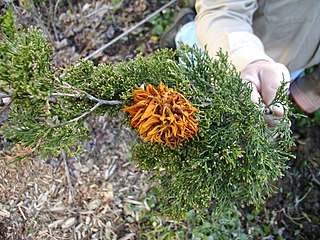
Gymnosporangium is a genus of heteroecious plant-pathogenic fungi which alternately infect members of the family Cupressaceae, primarily species in the genus Juniperus (junipers), and members of the family Rosaceae in the subfamily Amygdaloideae. The common name cedar-apple rusts has been used for these fungi. According to the Dictionary of the Fungi, there was 57 species in the genus. In 2023, Species Fungorum lists up to 74 species.

The Pucciniaceae are a family of rust fungi that cause plant diseases, mainly on cereals such as wheat. The family contains over 4900 species: many of them in the type genus Puccinia.
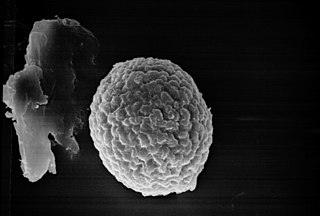
Tilletia is a genus of smut fungi in the Tilletiaceae family. Species in this genus are plant pathogens that affect various grasses. Tilletia indica, which causes Karnal bunt of wheat, and Tilletia horrida, responsible for rice kernel smut, are examples of species that affect economically important crops.
Ophiodothella is a genus of fungi in the family Phyllachoraceae.
Phomatospora is a genus of fungi within the class Sordariomycetes, and since 2016, in the family Phomatosporaceae and order Phomatosporales. They are found in terrestrial, freshwater and marine habitats, across the world except Russia and Canada.

Pucciniastrum is a genus of Basidiomycota fungi. Pucciniastrum species, like all rust fungi, are obligate plant parasites.
The Pucciniosiraceae are a family of rust fungi in the order Pucciniales. The family contains 10 genera and 57 species.
Olivea is a genus of rust fungi in the family Chaconiaceae. The widespread genus contains eight species that grow on dicots, especially the tropical flowering plant family Verbenaceae.

Chrysomyxa is a genus of rust fungi in the family Coleosporiaceae. The genus, widespread in the Northern Hemisphere, contains about 23 species. Rust fungi in the genus Chrysomyxa occur in boreal forests of the northern hemisphere on Pinaceae,, and most species alternate to angiosperm hosts in the Ericaceae.
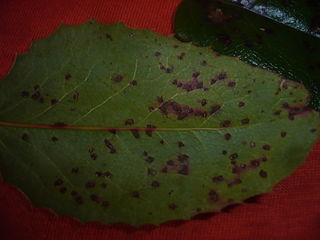
Cumminsiella is a genus of fungi belonging to the family Pucciniaceae.
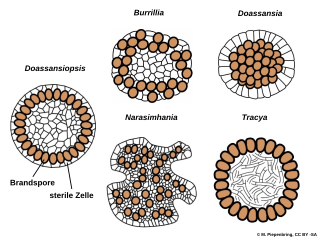
Doassansiopsis is a genus of smut fungi belonging to the monotypic family DoassansiopsidaceaeBegerow, R.Bauer & Oberw., 1998, within the class Ustilaginomycetes and order Urocystidales.
Pucciniosira is a genus of rust fungi belonging to the family Pucciniosiraceae.

The Zaghouaniaceae are a family of rust fungus genera, some of which have long been considered incertae sedis in the order Pucciniales, based on the type genus Zaghouania. The classification of fungal taxa based on only morphological characteristics has long been recognised as problematical, so this order was reviewed over a long-term study using three DNA loci and published in 2021.
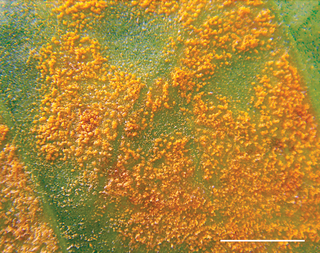
Hemileia is a genus of rust fungi, now placed in the family Zaghouaniaceae, but long considered incertae sedis in the order Pucciniales. This genus has a pan-tropical distribution and includes important crop plant pathogens, such as the causative organism of coffee leaf rust.
Uredo is a genus of rust fungi: long considered incertae sedis in the order Pucciniales, but now placed in the family Pucciniaceae. This long-established genus, together with the closely-related Uromyces, give their names to "uredo-type" fungal spore structures such as "urediniospore" and uredinium".
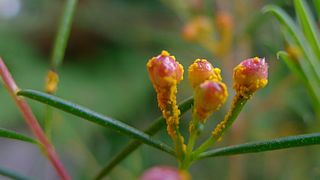
The Sphaerophragmiaceae are a family of rust fungus genera in the order Pucciniales, based on the type genus Sphaerophragmium and placed in the suborder Uredinineae.
References
- ↑ "Maravalia Arthur 1922". MycoBank. International Mycological Association. Retrieved 2011-07-10.
- ↑ Kirk PM, Cannon PF, Minter DW, Stalpers JA (2008). Dictionary of the Fungi (10th ed.). Wallingford, UK: CABI. p. 402. ISBN 978-0-85199-826-8.
- 1 2 "Species Fungorum - Search Page - Maravalia". www.speciesfungorum.org. Retrieved 27 August 2023.